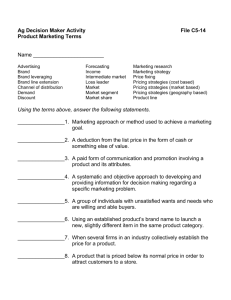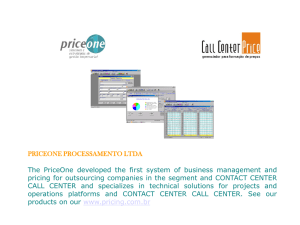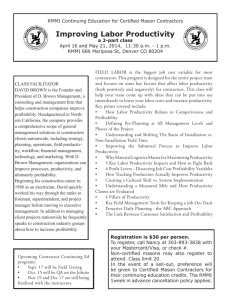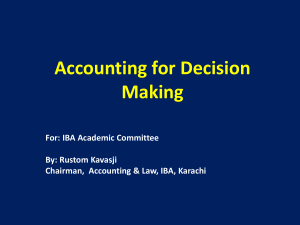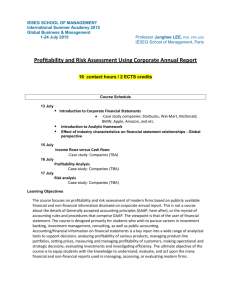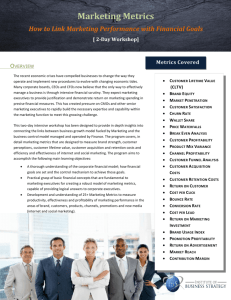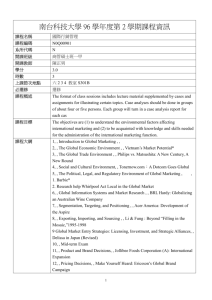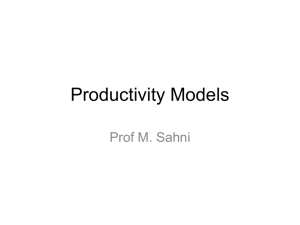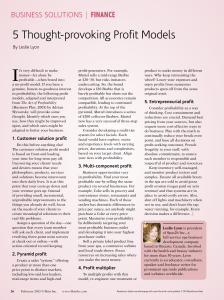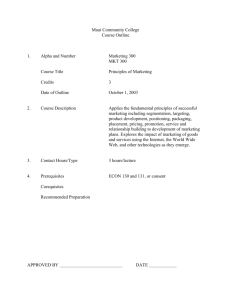29168,"red bull market share",10,11,"2000-02-14 00:00:00",110,http://www.123helpme.com/red-bull-market-share-view.asp?id=165996,2.5,13200000,"2016-02-28 08:17:07"
advertisement
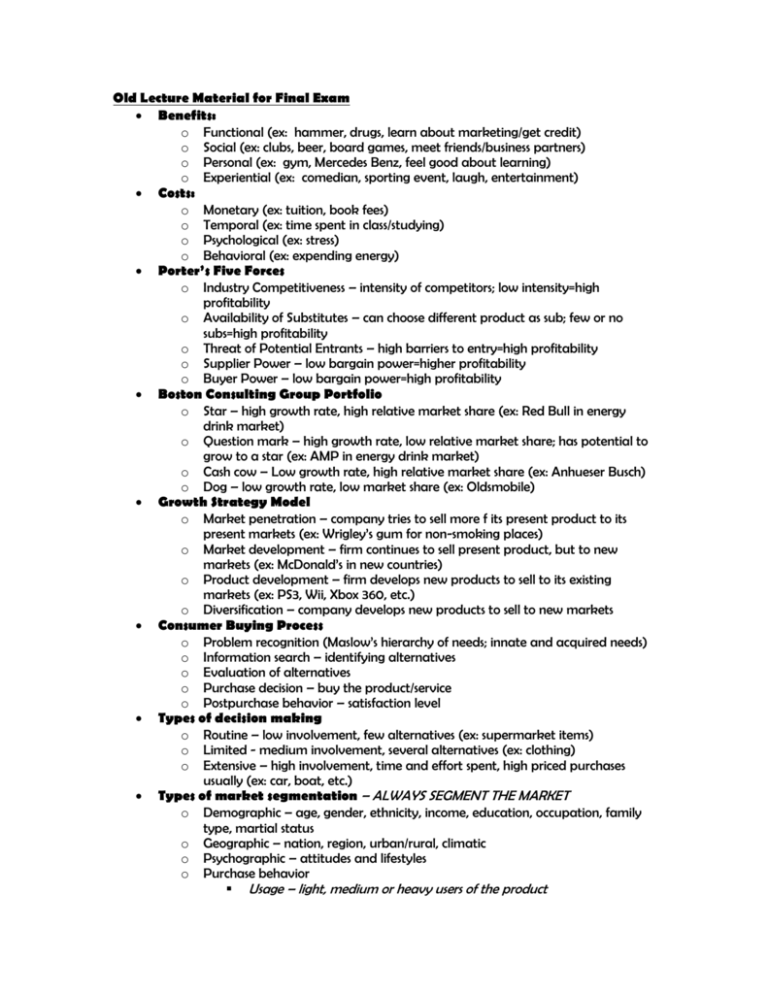
Old Lecture Material for Final Exam Benefits: o Functional (ex: hammer, drugs, learn about marketing/get credit) o Social (ex: clubs, beer, board games, meet friends/business partners) o Personal (ex: gym, Mercedes Benz, feel good about learning) o Experiential (ex: comedian, sporting event, laugh, entertainment) Costs: o Monetary (ex: tuition, book fees) o Temporal (ex: time spent in class/studying) o Psychological (ex: stress) o Behavioral (ex: expending energy) Porter’s Five Forces o Industry Competitiveness – intensity of competitors; low intensity=high profitability o Availability of Substitutes – can choose different product as sub; few or no subs=high profitability o Threat of Potential Entrants – high barriers to entry=high profitability o Supplier Power – low bargain power=higher profitability o Buyer Power – low bargain power=high profitability Boston Consulting Group Portfolio o Star – high growth rate, high relative market share (ex: Red Bull in energy drink market) o Question mark – high growth rate, low relative market share; has potential to grow to a star (ex: AMP in energy drink market) o Cash cow – Low growth rate, high relative market share (ex: Anhueser Busch) o Dog – low growth rate, low market share (ex: Oldsmobile) Growth Strategy Model o Market penetration – company tries to sell more f its present product to its present markets (ex: Wrigley’s gum for non-smoking places) o Market development – firm continues to sell present product, but to new markets (ex: McDonald’s in new countries) o Product development – firm develops new products to sell to its existing markets (ex: PS3, Wii, Xbox 360, etc.) o Diversification – company develops new products to sell to new markets Consumer Buying Process o Problem recognition (Maslow’s hierarchy of needs; innate and acquired needs) o Information search – identifying alternatives o Evaluation of alternatives o Purchase decision – buy the product/service o Postpurchase behavior – satisfaction level Types of decision making o Routine – low involvement, few alternatives (ex: supermarket items) o Limited - medium involvement, several alternatives (ex: clothing) o Extensive – high involvement, time and effort spent, high priced purchases usually (ex: car, boat, etc.) Types of market segmentation – ALWAYS SEGMENT THE MARKET o Demographic – age, gender, ethnicity, income, education, occupation, family type, martial status o Geographic – nation, region, urban/rural, climatic o Psychographic – attitudes and lifestyles o Purchase behavior Usage – light, medium or heavy users of the product Loyalty status – brand loyal or variety seekers User status – users vs. non-users, former users o Benefit – importance of a particular product benefit Positioning – the way a firm’s product, brand, or organization is view relative to the competition. Goal is to create a brand essence. Market demand methods o Market-factor analysis – demand is assumed relative to a behavior of certain sales activity (ex: ski resort uses snow to predict customers) o Survey of buyer intentions – how much customer would buy at a certain price and time o Past sales and trend analysis - % applied to volume achieved last year o Sales-force composite – salesmen estimate their sales for a period o Executive judgment – opinions from one or more execs on future sales o Test marketing – markets product in limited area and forecasts from there Primary Data – data that has to be collected o Observational, focus-group, survey, behavioral, experimental Secondary data – data that has already been collected. Always use first is possible because it’s cheaper. o Internal sources, government publications, periodicals and books, commercial data, online data Market share = firm’s sales ÷ industry sales Product life cycle o Introduction – stimulate demand for product, profits low, target innovators o Growth – competition expands, differentiate product, target early adopters o Maturity – sale plateau, competition intense, promotion increases while price decreases, target early majority and late majority o Decline – competition increases outside product class and decreases within product class, find new uses for product, target laggards Adoption process o Awareness – first exposure to product o Interest – consumer is interested in product and searches for info. o Evaluation – consumer decides whether or not product will satisfy a need o Trial – uses product on a limited basis o Adoption (rejection) Penetration pricing o Price is set low to gain immediate sales/market share, scare off entry. Hard to recover investment (ex: Microsoft IE, new airline route) Price skimming o Set price high to achieve quick/large profits (ex: Apple, Intel, Gillette Razors) Flexible pricing o Need a flexible pricing structure for products that are perishable: Foods – produce, breads, bakery items Services – airline flights, sporting events, concerts Short time demand- Christmas cards, high-fashion clothing Discriminatory pricing – legal as long as it doesn’t hinder competition substantially o Regional – Victoria’s Secret is more expensive in LA than STL o Time/age – movies charge different prices for rush hour shows and for seniors, students, and adults o Form discrimination – Evian 48 oz water for cheaper than 1.7 oz spray bottle moisturizer Coverage strategies – price goes up, intensity of distribution goes “down” o Intensive distribution Provide offering in as many outlets as possible Maximum coverage and no sale effort at point of purchase Usually low priced items Ex: gum, Hershey’s chocolate o Selective distribution provide offering in selective outlets (only some) middle ground- medium coverage and sales effort; need some sales effort ex: Compaq computers at Fry’s Computerland but not Sears o Exclusive distribution Using only one outlet in geographic area Maximum sales effort at the point of purchase, minimum coverage Ex: Ferrari, Rolex Promotion o Advertising – paid form of non-personal communication o Personal Selling – two-way, personal communication (face-to-face) o Public Relations – communications management that seeks to influence stakeholders (publicity, events, lobbying) o Sales Promotion – short-term inducement of value to arouse interest (ex: coupon, samples, contest) Factors affecting promotional mix: o Target audience, stage of product life cycle, product characteristics, buyer decision stage, distribution channel strategy Push strategy – target channel members o personal selling o sales promotion Pull strategy – target consumers/end users o Advertising AIDA o Attention – get the attention of the target market o Interest – generate interest in what you’re selling o Desire – build desire by using logic and emotion o Action – get target market to act; always call for action (sale)
